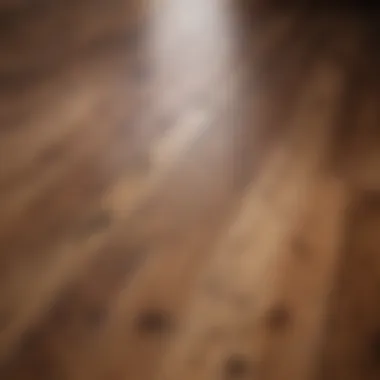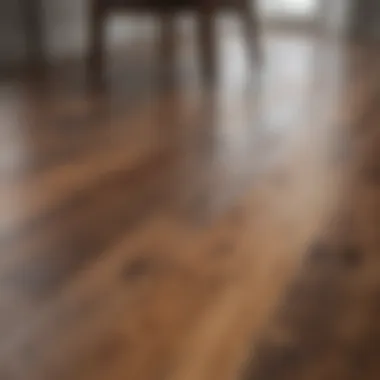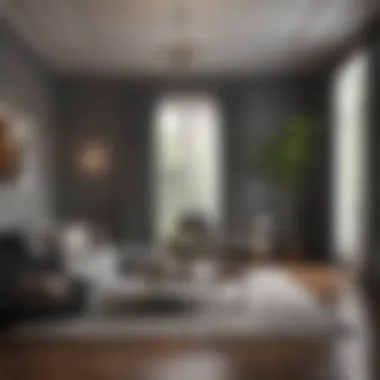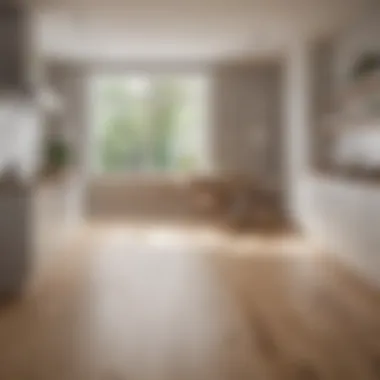Selecting the Perfect Hardwood Floor Color


Intro
Choosing the right hardwood floor color can be a significant decision in the realm of interior design. It involves looking beyond mere aesthetics. Factors such as lighting, room size, and personal style play crucial roles in this choice. When one selects a hue for hardwood flooring, it affects the mood of the space and the overall harmony of the home's design.
This guide aims to unpack the complexities involved in this decision-making process. Understanding the trends in colors and the classic options available will aid homeowners in creating a living space that reflects their style while ensuring practicality.
Selecting a color that complements various elements within the home will enhance its appeal and functionality.
Design Inspiration
When it comes to hardwood flooring, inspiration can be found in trending styles and themes that reflect contemporary tastes while accommodating classic designs.
Trending Styles and Themes
The current trend in hardwood floor colors leans toward warmer tones, which convey a sense of comfort and natural beauty. Among the notable styles, here are a few that homeowners may wish to consider:
- Rustic Charm: Emphasizing natural grains and textures, a rustic charm style can come alive with medium to dark browns, reminiscent of aged wood.
- Minimalist Approach: Light oak or ash colors work well with minimalistic aesthetics. They can create a clean and spacious look, often paired with white walls and sleek furniture.
- Modern Industrial: For those drawn to an industrial theme, darker colors with a matte finish can ground a space. Charcoal or deep browns can be successfully integrated with metal and concrete elements.
These styles not only enhance visual appeal, but they can also significantly impact how a room feels.
Color Palettes and Combinations
Understanding color combinations is essential. Here are some effective palettes when considering hardwood floors:
- Neutral Palette: Shades like beige, taupe, or gray work effectively with various color schemes, providing flexibility in decor.
- Monochromatic Scheme: Using floor colors that blend with the walls can create a flowing look. For instance, wooden floors in a soft whitewash can tie in beautifully with light wall colors.
- Contrasting Tones: To create drama, darker floors can contrast strikingly against lighter furniture or walls, enhancing the home's character.
"Selecting the right color for hardwood floors is key to achieving a cohesive and inviting interior design."
Incorporating these trends and palettes into your selection process can lead to a well-rounded design that is aesthetically pleasing and functional for daily life.
Prologue to Hardwood Flooring
Hardwood flooring is a choice that speaks volumes about a home’s aesthetic and functional qualities. Selecting the right hardwood floor color is not just about personal preference; it also sets the tone for the entire space. The choice influences how light interacts with the room and can either enlarge or constrict the perceived space. Furthermore, the color can add warmth, provide contrast, or even introduce a timeless feel to a room.
Choosing hardwood flooring involves careful consideration of various factors. The type of wood species can determine the natural color range available. Additionally, the specific finish enhances or alters these colors. Homeowners must be aware that certain stains can dramatically change the look of the wood, so it's relevant to explore the implications of color selection in-depth.
In this article, we will delve into why selecting the perfect color is crucial. We will highlight how the right choice not only complements existing decor but also elevates the home's overall appeal.
"A well-chosen hardwood floor color is like a seamless backdrop that enhances every element of a room."
Understanding the nuances involves examining the myriad factors that can influence color selection. From natural light patterns to the size and layout of the rooms, and even the existing interior design styles, every aspect plays a role in this choice. This journey is about finding the right balance between aesthetics and practicality, ensuring the final result satisfies both personal taste and functional needs.
Understanding Hardwood Flooring
Understanding hardwood flooring is essential for anyone considering it as a flooring option. Hardwood floors are made from solid wood cut from trees, which gives them a unique combination of durability and beauty. The range of colors and grains available offers endless possibilities for interior design.
Hardwood floors can be divided into two categories: solid and engineered. Solid hardwood floors consist of a single piece of wood, while engineered hardwood is constructed with multiple layers. This second option often provides increased stability and resistance to humidity, making it suitable for various environments. Each type may respond differently to stain and finishes, which affects the overall visual impact of the flooring.
Additionally, different hardwood species bring their own characteristics. For instance, oak is known for its strength and classic look, while maple offers a lighter color and fine grain. Understanding these fundamental differences will guide homeowners in selecting the flooring that aligns with their vision.
Types of Hardwood Species
When selecting hardwood flooring, understanding the types of hardwood species is crucial. Each type has distinctive attributes, including color, grain pattern, and hardness. Here are some common species:
- Oak: This is one of the most popular choices for hardwood flooring, known for its durability. It comes in two main varieties: red oak, which has a pinkish hue, and white oak, offering a more muted tone.
- Maple: Maple flooring is often lighter in color with a subtle grain. It is hard and resistant to wear, making it ideal for high-traffic areas.
- Cherry: This species is famous for its rich, warm tones. Cherry wood tends to deepen in color over time, adding to its appeal.
- Walnut: Walnut features a dark, luxurious look. Its intricate grain patterns can add depth and richness to any space.
- Hickory: Known for its striking contrasts in grain and color, hickory flooring is durable and suitable for rustic designs.


Each species can be stained or finished in various ways, allowing for a wide range of hues and effects. Making an informed decision means considering not only the initial look but also how the wood will age and fit with other design elements in the home.
Factors Influencing Color Selection
Room Size and Layout
The size and layout of a room play a critical role in selecting hardwood flooring color. Larger rooms may allow for darker shades without making the space feel closed in. Conversely, in smaller spaces, light-colored wood can create an illusion of expanded size, making the area feel airy and open. Here are some factors to consider:
- Color Depth: Darker colors can add warmth but may make a small room feel more intimate.
- Proportion: The relationship between the size of the room and the color of the floor is vital. Lighter tones can contrast nicely with dark furniture.
Also, think about the layout. An open floor plan might benefit from a continuous color that flows through different rooms. Yet, distinct colors in separate areas can help define spaces.
Lighting Considerations
Light is a fundamental element when choosing hardwood floor colors. Natural light changes throughout the day, affecting how colors appear. Analyzing this aspect is crucial.
- Natural Light: Rooms with ample sunlight may handle darker shades better, while low-light spaces often benefit from lighter tones.
- Artificial Lighting: Different types of bulbs impact how colors reflect. For instance, fluorescent lights can make floors look cooler, while incandescent lights provide warmth.
It is wise to test samples during various times of the day to see how the colors change with light. This step ensures that the chosen hue remains consistent with your vision regardless of the time.
Existing Decor and Style
Your current decor and personal style are significant when selecting hardwood flooring colors. The flooring should complement furniture, wall colors, and overall aesthetic.
- Color Harmony: Select a floor color that synergizes with the existing palette. A contrasting floor might make the space feel disjointed.
- Style Compatibility: Consider your home's architectural style. Traditional homes may find elegance in warmer, richer hues, whereas modern spaces might benefit from cooler, minimalistic tones.
By considering these existing elements, homeowners can create a cohesive and inviting environment. Nevertheless, introducing a new color that stands out can also be a bold choice, provided that it is executed thoughtfully.
Selecting the right hardwood floor color is a blend of art and science, demanding careful thought in context with spatial and design factors.
Color Options for Hardwood Floors
Selecting the color of hardwood flooring is more than just a matter of visual appeal; it establishes the foundation for the entire room's atmosphere. The vast array of color options available can create different feelings and complement various design styles. This section delves into the significance of choosing the right color for hardwood floors, elaborating on the diverse spectrum available from light to dark shades, including custom staining techniques that allow for personalized aesthetics.
Light Colors
Light-colored hardwood floors are often favored for their airy and spacious appearance. These tones can visually expand a room, making them ideal for smaller or poorly lit spaces. Common light shades include natural oak, maple, and white ash. These choices typically reflect more light, contributing to a bright and welcoming environment.
Benefits of light colors:
- Increased light reflection, enhancing room brightness.
- Versatile combinations with various decor styles, from contemporary to classic.
- Easier to maintain, as dirt and dust may be less visible.
However, there are a few considerations with light colors. They might show wear and scratches more prominently over time. Homeowners should balance aesthetic appeal with practical maintenance needs.
Medium Tones
Medium tones represent a popular middle ground, combining warmth and elegance. Ash, hickory, and walnut are examples of this category. These shades provide a balanced feel, neither too bright nor too dark, allowing for warmth without overwhelming the space.
Furthermore, medium tones can integrate well into various design themes. They offer a coherent backdrop that works with both darker and lighter furnishings.
It is important to note that medium colors have various undertones, such as golden, reddish, or grey. Understanding these undertones is key to achieving the desired cohesion within the existing palette of the room.
Dark Shades
Dark hardwood floors can evoke sophistication and richness. Popular options include Brazilian cherry, mahogany, and darker oaks. These colors contribute to a strong, dramatic effect that can anchor a room's design. A dark floor can be particularly striking in larger spaces or rooms with high ceilings.
Benefits of dark colors include:


- Creating a warm and cozy atmosphere.
- Concealing scratches and dust more effectively than lighter shades.
- Offering a bold contrast against lighter walls and furniture.
However, dark shades may absorb more heat and require more frequent cleaning to maintain their luster. Homeowners must consider these factors when deciding on dark flooring options.
Custom Staining Techniques
Custom staining provides an opportunity for homeowners to achieve a unique look. This approach involves applying finishes that can change the wood’s original hue and add depth or character. Stains can range from subtle tints to vibrant colors, facilitating a personalized touch.
With custom staining, it is crucial to consider the following:
- Test stains on samples before applying them to the entire floor.
- Think about the final finish; matte vs. gloss can significantly alter appearance.
- Ensure the selected stain complements the overall design.
Investing time into exploring these color options ensures that the flooring aligns with personal tastes and functional needs, creating a space that feels just right.
Current Trends in Hardwood Floor Colors
In the world of interior design, staying abreast of current trends is essential for creating spaces that are not only functional but also aesthetically pleasing. The color of hardwood floors can significantly impact the overall ambiance of a room. Current trends in hardwood floor colors reflect broader shifts in design philosophy and consumer preferences. By understanding these trends, homeowners and interior design enthusiasts can make informed decisions about the best hues for their spaces.
The importance of this topic cannot be understated. Trends often serve as indicators of taste and style, providing insights into what is well-received in various communities. These preferences evolve with time, influenced by cultural factors, innovations in materials, and environmental consciousness. Hence, knowing what colors resonate can aid significantly in crafting an environment that feels updated and inviting.
Popular Colors of the Year
The hardwood floor color palette for this year leans towards a balance of classic and contemporary choices. Some prevalent choices include:
- Soft grays: Ideal for modern designs, these shades can bring a calming yet stylish look to any room.
- Rich browns: Still a favorite, deep, warm browns remain popular for traditional settings, offering timeless elegance.
- Natural beiges: As design moves towards a more organic feel, lighter hues that mimic natural wood tones are increasingly favored.
- Whitewashed finishes: These not only brighten spaces but also enhance the grain patterns of the wood, creating a unique visual appeal.
The shift towards lighter and neutral tones signifies a desire for versatility, as these colors can accommodate various decor styles while maximizing the space's perceived size.
Sustainable Choices
In line with growing environmental awareness, sustainable materials are becoming a significant focus in flooring choices. For hardwood floors, sustainability implications go beyond the family of wood species. Many brands are adopting eco-friendly practices such as:
- Sourcing wood from sustainable forests
- Using non-toxic finishes and stains
- Promoting engineered wood products that consume fewer resources
Consumers today often choose options that minimize their ecological footprint. For example, bamboo flooring has gained popularity due to its rapid growth cycle and renewable resources. Moreover, reclaimed wood flooring serves both style and sustainability as it repurposes existing materials, reducing waste.
"Investing in sustainable hardwood flooring not only enhances your home but also contributes to a healthier planet."
In sum, the current trends in hardwood floor colors mirror a transformation in homeowner sensibilities. A combination of popular color choices and a commitment to sustainability highlights a conscientious approach to interior design, blending aesthetics with personal and ecological responsibility.
Balancing Aesthetics and Practicality
Choosing the right hardwood floor color entails more than just personal taste; it also requires a judicious consideration of practicality. A balance between aesthetics and functionality is vital for creating a harmonious living space. The color and finish of hardwood flooring can influence how a room feels. Lighter tones can evoke a sense of spaciousness, while darker shades may bring warmth and coziness. However, aesthetic choices must align with practical needs such as durability, maintenance, and environmental conditions.
It is essential to consider the way the selected floor color will hold up over time. A beautiful hardwood floor can lose its charm when its finish wears away or when it shows signs of damage. Therefore, choosing a color that can complement your maintenance routine is crucial. This involves understanding wear patterns based on foot traffic, sunlight exposure, and the general use of the space.
There are various benefits to achieving this balance:
- Functionality: Selecting a color that enhances visual appeal while serving practical needs ensures longevity.
- Versatility: A well-chosen color can adapt to seasonal changes and shifts in decor trends.
- Value Enhancement: Thoughtful color choices can raise the inherent value of the property, making it more appealing to potential buyers or tenants.
Ultimately, a practical approach to their aesthetic choices can lead to increased satisfaction with home interiors.
Durability of Color Treatments
The durability of color treatments stands as a cornerstone in the discussion of hardwood flooring. Different finishes and stains react uniquely to everyday wear and tear. For instance, water-based polyurethane tends to dry clear and retains the hardwood’s original hue, while oil-based alternatives might darken the wood over time but provide a richer finish. It is crucial to evaluate the specific needs of each room when assessing treatment durability.


Hardwood floors in high-traffic areas, like hallways and living rooms, require more robust treatments. Such treatments need good resistance against scratches and dents. Colors that tend to show wear, like dark shades, may require more frequent refinishing. It's also worth noting that lighter colors might better camouflage dust and minor scratches, contributing to a more lasting aesthetic appeal.
Some of the options for durable treatments include:
- Finish Type: Urethane finishes provide longevity.
- Stain Choice: Certain stains are formulated for high durability, resisting fading.
"The right color and finish combination will help maintain the beauty of hardwood floors over time, aligning aesthetics with function."
Maintenance Considerations
Maintaining hardwood floors is not only about regular cleaning; it is also about protecting the color and appearance of the wood. The choice of color plays a significant role in the maintenance regimen. Darker colors can easily show dust and pet hair, requiring more frequent cleaning. In contrast, lighter shades allow for a bit more leeway in this regard but may require additional sealing to protect against stains.
Here are key maintenance considerations:
- Cleaning Products: Using pH-balanced or hardwood-safe cleaners is crucial to avoid damage to the finish.
- Preventing Scratches: Placement of area rugs in high traffic areas, alongside felt pads under furniture, can significantly reduce surface damage.
- Regular Refinishing: Over time, refinishing will help to restore the wood’s original color and shine, making periodic assessments necessary.
Final Thoughts on Color Selection
Choosing the right color for hardwood floors is a significant decision that impacts the overall aesthetic of a home. It is, therefore, essential to reflect on several aspects that arise throughout the selection process. The final thoughts on color selection serve to synthesize the critical points made earlier in the article. The importance of achieving a harmonious relationship between the flooring and the surrounding design elements cannot be overstated. A carefully chosen color can enhance the beauty of a room while also optimizing its function.
Cohesion in interior design is achieved through thoughtful color choices. When selecting a hardwood floor color, consumers must consider the existing decor, style, and atmosphere they desire to create. A successful color selection ensures that the flooring complements other elements such as furniture, wall colors, and accessories. Moreover, maintaining consistency across different spaces within the home strengthens the overall design narrative.
"It is crucial to remember that the floor is a foundational component of interior design, just as walls and furnishings are."
Aside from aesthetic considerations, practicality must join the conversation. Functionality often dictates the choice of flooring color. For instance, darker shades may hide dirt and wear better than lighter hues, making them ideal for high-traffic areas. On the other hand, lighter colors can create an illusion of more space and reflect light better, contributing to a brighter atmosphere.
Alongside these aesthetic and practical aspects, consulting with professionals can further enhance the decision-making process. The expertise of designers and flooring specialists can guide homeowners in avoiding common pitfalls related to color selection. The final thoughts on color selection should thus highlight that a well-informed choice encompasses both personal tastes and professional guidance, ensuring a suitable outcome for the intended environment.
Achieving Cohesion in Design
Achieving cohesion in design involves a careful evaluation of the relationship between flooring and overall room characteristics. Prospective buyers should think about how the floor color supports or contrasts with existing elements in the home. A cohesive design is often visually pleasing and can create an inviting atmosphere.
- Consider the surrounding colors: Take note of wall paints, furniture, and decor accents. Selecting a floor hue that harmonizes with these elements will draw the eye through the space and create a unified look.
- Use a color wheel for guidance: Familiarize yourself with basic color theory. Neutrals often work wonders for blending, while complementary colors can create bold statements.
- Mind the architectural style: Traditional homes might benefit from warmer, classic tones, while modern designs may lean towards cooler, understated colors.
Consulting with Professionals
Homeowners must not shy away from seeking professional input in their flooring color selection. Designers possess knowledge and experience that can help streamline the process. Engaging with experts also allows for exploring unique staining techniques or lesser-known color options that may not be on a typical consumer's radar.
- Collaborative discussions can reveal insights: A professional could provide perspective on trends or practical implications of certain colors under varying light conditions.
- Utilize virtual design tools: Many professionals now offer digital consultations. This technology can simulate how different colors might appear in your space, aiding in better decision-making.
- Seek customized solutions: Professionals can tailor their recommendations to suit personal tastes while aligning with current design trends.
Resources for Further Learning
Understanding the nuances of selecting the right hardwood floor color requires more than just personal preference. A deep dive into available learning resources can significantly elevate your decision-making process. This section aims to highlight various tools for knowledge enhancement, from literature to structured learning modules. The importance of this knowledge lies in its ability to inform choices, inspire creativity, and ensure that selections meet both aesthetic and functional needs.
Books and Magazines
Books and magazines dedicated to interior design and flooring showcase diverse perspectives and expert insights. They often cover trends, practical tips, and case studies relevant to selecting flooring colors and styles. Consider the following:
- Interior Design Books: Titles such as The Interior Design Reference & Specification Book provide foundational understanding and detail about different materials, including hardwood.
- Home Improvement Magazines: Publications like Better Homes & Gardens frequently feature articles that highlight current flooring styles. They also include images and suggestions for how to incorporate colors effectively in various settings.
- Specialized Flooring Publications: Look for resources that focus specifically on flooring. These might offer in-depth looks at wood species, finishes, and color selection strategies.
Through these materials, homeowners and design enthusiasts can gain insights that will inform their choices and enhance their understanding of the broader contexts in which these products exist.
Online Courses and Tutorials
The digital landscape offers a plethora of online courses and tutorials that cater to various skill levels. These resources can provide a structured approach to learning about hardwood flooring.
- Websites like Udemy or Coursera offer courses on interior design fundamentals and material selection. Participants can learn from industry professionals about color theory and application in real-world scenarios.
- YouTube Tutorials can be an invaluable resource for visual learners. Many experienced designers share their expertise on selecting hardwood flooring colors, demonstrating practical techniques that can be applied at home.
- Interactive Webinars and Workshops often bring together experts for live learning. These sessions can cover everything from color psychology to practical demonstrations of techniques used in flooring installation.
Overall, engaging with these resources will enhance not only the knowledge base but also the confidence needed to select a color that complements the space effectively.
"Knowledge is power when it comes to creating a harmonious living space."
Utilizing these books, magazines, courses, and tutorials can provide the depth of understanding necessary for making informed choices about hardwood flooring colors, ensuring that your selections are both beautiful and functional.



